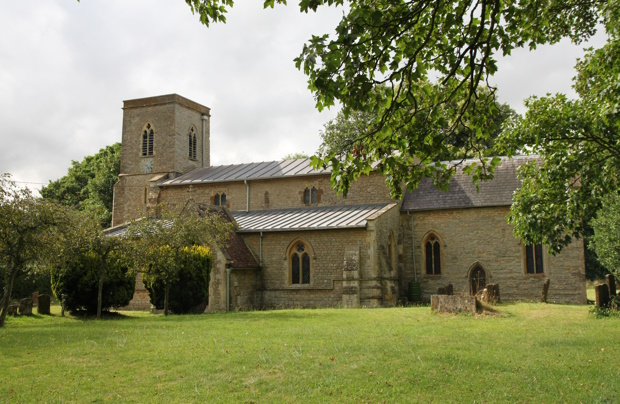


























The Church of St. Michael and All Angels, Fringford
The Church of St. Michael and All Angels in Fringford is a stone building comprising a chancel, clerestoried nave with three bays, two aisles, and a western tower. The only remains of the 12thcentury church are a much restored south door and the two northern arches of the nave. The threearched south arcade, of which two of the pillars are decorated with curiously carved grotesque female heads, probably dates from the 13th century. The south aisle (see below) may have been rebuilt in the 14th century. At the north-west end of the nave is a blocked-up arch. In the 16th century there were altars to Sts. Catherine and Thomas. The roughly carved medieval screen has been preserved. Small repairs are recorded at several dates in the 18th century: in 1739; between 1765 and 1792, when sums ranging from £1 to £9 were paid to local craftsmen; and in 1788 when £14 odd was spent on replastering and painting the interior and retiling the roof. In the 19th century the church was largely rebuilt: in 1804 and 1809 a total of £60 was paid for work on the fabric; in 1812 £38 on the tower; in 1821 a new chancel was built at the rector's expense and the parish spent £34 on the main body of the church. In 1829 the north aisle was rebuilt, and in 1831 £237 was spent on replacing the wooden belfry by the present stone tower. The mason was Daniel Mansfield of Hethe. In 1838 and 1841 the church was reseated; in 1856 and 1857 the original Early English porch was taken down and replaced and the south aisle was rebuilt and enlarged by the architect G. E. Street at a cost of £650. In 1905 the north aisle was enlarged and rebuilt at the expense of H. J. Chinnery (architect T. B. Carter) and two clerestoried windows on the north were opened. The altar was removed from the chancel to the north aisle to form a chapel and a new altar erected in the chancel. In 1909 the roof was restored. The church has had three fonts in recent times. In the early 19th century there was a plain circular one. The origin of the fine octagonal font, decorated with four heraldic stone shields, which was presented in the late 19th century, is uncertain. In 1880 a new font, in memory of Mrs. Anne King, replaced the latter, but both are now in the south aisle. In 1842 the church was beautified at the expense of the rector Henry Roundell and Miss Roundell. The clerk's desk was altered and a new pulpit was erected. The pulpit's finely carved 17th-century panels are said to have been bought from the manor-house at Hardwick. Crimson furnishings for the communion table, pulpit, and reading-desk, and kneeling-cushions were provided. A vestry was made in the same year and additional open sittings were provided in 1842 and 1847. In 1855 the Roundell family paid for fitting two of the chancel windows with stained glass. The rector Henry de Salis gave a new organ in 1859; its case was made by John Rogers of Fringford, a local carpenter, who was also responsible for the carved seats in the nave and was church organist for many years. The clock in the tower dates from 1876. There is a stone tablet in the chancel to Richard Wenman (d. 1637/8), and two fine marble monuments on the north side of the nave to the Addington family: one to Anthony Addington (d. 1790) and his wife Mary (d. 1778) is signed by Richard Westmacott and is surmounted by arms; the other is to Henry Addington (d. 1729/30) and his wife Elizabeth (d. 1746). There are also memorials to Daniel Wardle, rector (d. 1756), John Russell Greenhill, rector (d. 1813), Elizabeth Greenhill, his wife (d. 1807), Richard Gibbs, gent. (d. 1807) and family, Henry Dawson Roundell, rector (d. 1852), Cadwallader Coker, rector (d. 1894), and H. J. Chinnery, J.P. of Fringford Manor (d. 1914). Tablets commemorate the charitable bequests by Elizabeth de Salis and John Mansfield. In 1552 the church owned a silver chalice and some vestments. There was also a light, the donor of which was unknown, supported by lands worth 6d. a year and five sheep and two lambs valued at 10s. The church now possesses an Elizabethan chalice and some Victorian silver given by Eleanor Roundell. At the Reformation there were three bells, a sanctus bell and two handbells; the present tower has a ring of three bells, one dating from the early 16th and two from the early 17th century. There is an 18th-century saunce. The bells were repaired and a new bell-frame was erected by John Waters in 1832. No trace remains of the medieval cross once in the grave yard. As early as 1633 a Fringford man stated that he could not remember any cross there but only a heap of 'rubbidge stone'. The registers begin in 1586 for marriages, in 1588 for burials, and in 1596 for baptisms. From 1640 to 1660 they are irregular, and there is a gap 1736–51. There is a book of churchwardens' accounts from 1751 to 1921. Historical information about St Michael's Church is provided by 'Parishes: Fringford', in A History of the County of Oxford: Volume 6, ed. Mary D Lobel (London, 1959), pp. 125-134. British History Online http://www.british-history.ac.uk/vch/oxon/vol6/pp125-134 [accessed 31 January 2023]. St. Michael's Church is a Grade II listed building. For more information about the listing see CHURCH OF ST MICHAEL AND ALL ANGELS, Fringford - 1369783 | Historic England. For more information about St. Michael's Church see Parishes: Fringford | British History Online (british-history.ac.uk) |

